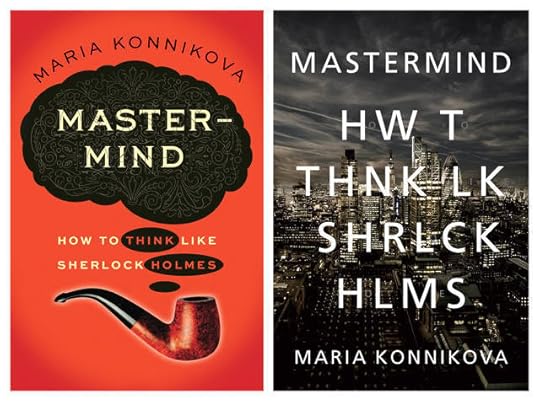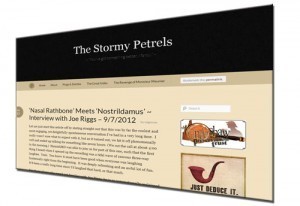Joe Riggs's Blog, page 2
May 7, 2013
Myself + A Cigarette Lighter = A Wild Guitar Experience Sitting In With A Band Tonight…
For those of you who don’t know, aside from being a Mentalist & Psychological Entertainer I am also an avid Musician. People often ask me why I don’t share any of my musical talents with the world. So, tonight while watching some friends play music in a bar, I decided to sit in and get a little crazy on the guitar.
I’ve always had a very original approach to the guitar, but tonight I may have taken that to a new level. I hope you guys enjoy this.
—————————————————————————————————
Joe’s book (raising funds for Save Undershaw) ‘The Real Sherlock Holmes‘ is available all good bookstores including Barnes and Noble, Amazon, and in all formats including Amazon Kindle and now on the iPad too. Fans outside the US and UK can get free delivery from Book Depository.





April 23, 2013
The Shackles Of Sherlock Holmes With David Burke – A Must See Documentary…
Hello friends, I thought I would take a quick detour from the usual articles, interviews & reviews I post and share something I absolutely adore with you. I’ve seen a plethora of Sherlock Holmes related documentaries in my day, yet very few that pleased me as much as this one did.
Hosted by David Burke, who was of course Dr. Watson alongside the incredible Jeremy Brett in the wonderful Granada series. This documentary focuses on letters actually written by Sir Arthur Conan Doyle to his family and friends, regarding his success and struggles with his beloved fictional detective, Sherlock Holmes. Enjoy!
—————————————————————————————————
Joe’s book (raising funds for Save Undershaw) ‘The Real Sherlock Holmes‘ is available all good bookstores including Barnes and Noble, Amazon, and in all formats including Amazon Kindle and now on the iPad too. Fans outside the US and UK can get free delivery from Book Depository.





April 17, 2013
Graphology: A Deductive Dive Into The World Of Handwriting Analysis…
Before we begin here’s a few words on the subject of Graphology from Sherlock Holmes and Professor Moriarty in the film “Sherlock Holmes: A Game Of Shadows” courtesy of Warner Brothers:
This interaction actually brings up a few points I want to make before we actually jump into learning about handwriting analysis. You’ll notice that Moriarty, a scholar, says “I’ve never given it any serious thought.” This is actually true of many scholars today. When it comes to Graphology there is a mixed bag of opinions on its usefulness and/or legitimacy I would like to address this and give you my thoughts on the matter.
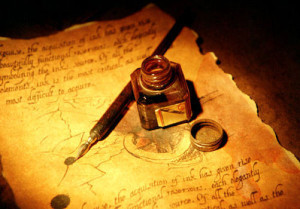 While the study of Graphology is widely accepted there are those who use nothing more than Cold Reading under the guise of Graphology. In other words, they pretend to be ascertaining information from the subjects handwriting when in reality they are making declarations that would apply to anyone. Much like the weekly horoscope in newspapers, they are general yet feel specific. This is known as the Barnum, or Forer Effect. Due to this many have snubbed their nose at Graphology as a whole.
While the study of Graphology is widely accepted there are those who use nothing more than Cold Reading under the guise of Graphology. In other words, they pretend to be ascertaining information from the subjects handwriting when in reality they are making declarations that would apply to anyone. Much like the weekly horoscope in newspapers, they are general yet feel specific. This is known as the Barnum, or Forer Effect. Due to this many have snubbed their nose at Graphology as a whole.
On the other hand there are entire institutes devoted to Graphology and many professionals, myself not excluded, that can deduce accurate psychological traits of a person based on their handwriting. Just like in any other arena there are charlatans that give the art a questionable name. In this article I will be sharing the methods and techniques that I’ve found to be quite reliable in this field. As always, confirm your deductions with evidence, and see for yourself what works, and what simply does not. Interestingly enough as a performer I have often used advanced cold reading combined with legitimate Graphology to achieve amazing results, for theatrical purposes.
The above video is an example of that, while Sherlock did state some valid Graphology techniques he also used what he already knew of Moriarty to be ‘more’ specific than he would have been otherwise. With that being said, let us begin.
Graphology is the pseudo-scientific study and analysis of handwriting, especially in relation to human psychology. The term is sometimes incorrectly used to refer to forensic document examination. Forensic document examination is a science used to ascertain the validity as well as other aspects of documents in a court of law. Graphology however, focuses on psychological traits that can be ascertained from one’s handwriting.
Graphology has been controversial for more than a century. As I stated earlier, many of us that study this art have found many of it’s teachings to be quite useful, while at the same time many of it’s larger more fantastical claims to be just that. Again, I will only be teaching the techniques that I’ve personally found to be of use in my work. Graphology depends on a few simple assertions, they are as follows:
When we write, the ego is active but it is not always active to the same degree. Its activity waxes and wanes; being at its highest level when an effort has to be made by the writer and at its lowest level when the motion of the writing organ has gained momentum and is driven by it.
When the action of writing is comparatively difficult, the writer uses those forms of letters which are simpler or more familiar.
The muscular movements involved in writing are controlled by the central nervous system. The form of the resultant writing movement is modified further by the flexibly assembled coordinative structures in the hand, arm, and shoulder; which follow the principles of dynamical systems. The specific writing organ (mouth, foot, hand, crook of elbow) is irrelevant if it functions normally and is sufficiently adapted to its function.
The neurophysiological mechanisms which contribute to the written movement are related to conditions within the central nervous system and vary in accordance with them. The written strokes, therefore, reflect both transitory and long term changes in the central nervous system such as Parkinson’s disease, or alcohol usage.
The movements and corresponding levels of muscular tension in writing are mostly outside of conscious control and subject to the ideomotor effect. Emotion, mental state, and biomechanical factors such as muscle stiffness and elasticity are reflected in a person’s handwriting.
One must examine the handwriting or drawing movements by considering them as movements organized by the central nervous system and produced under biomechanical and dynamical constraints. Given these considerations, graphologists proceed to evaluate the pattern, form, movement, rhythm, quality, and consistency of the graphic stroke in terms of psychological interpretations. Such interpretations vary according to the graphological theory applied by the analyst.
Most schools of thought in graphology concur that a single graphological element can be a component of many different clusters, with each cluster having a different psychological interpretation. The significance of the cluster can be assessed accurately by tracing each component of the cluster back to their origins and adapting the meaning of the latter to the conditions of the milieu in which the form appears.
No single handwriting feature proves anything specific or absolute by itself; a single feature alone can only identify a 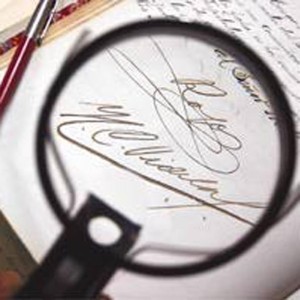 trend. It is the combination of features, and the interaction between them that enable a full and clear interpretation. Graphology is actually very old, the study of handwriting and its analysis was first developed by the Chinese 3,000 years ago. The Romans used graphology, and through the centuries since then various civilizations and cultures have analyzed handwriting to identify the essence of the person who produced it.
trend. It is the combination of features, and the interaction between them that enable a full and clear interpretation. Graphology is actually very old, the study of handwriting and its analysis was first developed by the Chinese 3,000 years ago. The Romans used graphology, and through the centuries since then various civilizations and cultures have analyzed handwriting to identify the essence of the person who produced it.
The modern approach to handwriting analysis was established by a group of French clerics, led by Abbe Michon, who defined key aspects of the science in the 1870s, after 30 years of study. This work formed the basis of modern graphology, although the science is still being researched and expanded today. We will now dive into some of the teachings I find to be the most interesting and useful.
First we will talk about the ‘perfect’ handwriting sample. While an experienced Graphologist can work with nearly any handwriting sample, most professionals agree that for the most accurate analysis you should follow a few rules in gathering your sample. You may or may not believe it but even if you try to manipulate your handwriting, a graphologist scholar will tell you who you are, by merely analyzing your handwriting. However, there are a few prerequisites that one needs to follow.
1. It is best to use non ruled/unlined paper.
2. The pen used by the writer should be the regular one he/she uses. A fountain pen or a ball point is ideal. Pencils are generally frowned upon.
3. The ideal writing sample is at least 100 words, although this is not an absolute.
4. Anything that has been copied from another document, like a poem, will reflect the original and is frowned upon.
Having said that, let’s get into the actual handwriting analysis itself… Finally… 

The three zones in Graphology, these will be referenced often.
Baseline
This refers to the direction written across the page. For example, if the paper was lined, a straight baseline would be writing that is written directly on the line all the way across the page. As found in every book or printing.
Generally Straight: Often indicates that the writer needs control in his/her life to be comfortable.
Ascending to the Right: Optimistic, looks forward to the future, excitable, joyous and invigorated.
Descending Slant: Pessimism, fatigue, discouraged, depressed, can also indicate many forms of illness.
Arc: An arc shaped baseline more often than not indicates one who often does not follow through, quite often a writer that would start a project enthusiastically yet later gives up and leaves things unfinished.
Concave: The writer is generally a slow starter and lacks confidence or purpose. However, as the project begins, the writer will overcome the negativity. It is difficult for this writer to start a project but easier to finish one.
Slant
Left Slant: Most of the strokes will end up at an angle to the left of 90 degrees. People with this trait can often have a hard time expressing their feelings and connecting with other people. In context this can often indicate lack of trust. This writer needs to be true to self first and foremost and can be resentful if others try to push for more commitment from them.
Right Slant: Indicative of a person ruled by their heart and not their head. This is known to be a person who is impulsive and lets their emotions rule their life more so than the emotionally withdrawn person.
Straight: If the handwriting is mostly upright, this can indicate independence and/or confidence. More-so than the left or right slant writer. Again, there are no absolutes here.
Uneven Slant: In graphology whenever the writing becomes uneven then this means that the writer is moody or at is least experiencing different moods while writing.

This is a very general diagram of Slant in Graphology.
Size
Handwriting is made up of three zones, middle, upper and lower. A basic average measure or baseline by which size can be judged is 3mm per zone. This gives a baseline for a non-remarkable full height of 9mm. More than this is large; less than this is small. See the above diagram.
Large size handwriting can mean extroverted and outgoing, or it can mean that the writer puts on an act of confidence, although this behavior may or may not be exhibited to strangers.
Small size can, obviously, mean the exact opposite. Small size handwriting can also indicate a thinker or an academic, depending upon other features in the sample.
If the writing is small as well as delicate, this often indicates shyness. The writer is unlikely to be a good communicator with anyone other than those they feel a level of rapport with. These people do not generally find it easy to be outgoing socially.
Pressure
Heavy pressure: Generally indicates commitment and a serious personality, however if the pressure is unusually heavy, that person could tend to be very uptight at times and can react quickly to constructive criticism. Such individuals tend to react first and ask questions afterwards.
Light pressure: Shows sensitivity to surroundings and empathy to people, yet can also indicate, if the pressure is uneven, show lack of vitality and drive or motivation.
Rhythmic Changing Pressure: Artistic, aesthetic, warm, likes colors, charming personality. If pressure is absent on the left-descending upper zone strokes, a fear of the past is implied. If the pressure is present on the right-ascending upper zone strokes then, one suspects something fearful in the future. Sudden intensity in the pressure can show quick temper or emotional intensity.
Upper Zone or Case (shown often in: l, t, h, etc…)
Tall upper strokes that reach into the upper zone can indicate reaching towards goals and/or ambitions. Yet if they are extremely extended, this is generally indicative of unrealistic expectations and/or one that sets unreachable goals.
Some Graphologists teach that if the upper zone loops are average in size the writer would tend to be someone who likes to think things through and is sensible. Larger and wider upper zone loops likewise indicate a dreamer and/or one who ponders their ideas/goals excessively.
Word Spacing
The baseline to judge wide or narrow spacing between words is the width of one letter of that particular person’s handwriting. Wide spaces between words often indicate, quite simply, someone needing/wanting space at the time of writing or in general, depending on the context.
Narrow spaces between words indicate a a wanting or longing to be with/around others, but such writers may also crowd people and be intrusive, and context is key here.
Line Spacing
Handwriting samples are always best on un-ruled/unlined paper, especially for deductions regarding line-spacing features.
Wide-spaced lines of handwriting can indicate an observer, one who prefers to stand back from the crowd.
Closely spaced lines indicate that that the writer operates up close and personal, so to speak.
Middle Zone Types:
Arcade
This means that the middle zone of the writing is rounded at the top like a series of arches. Nearly all Graphologists agree that arcade indicates one who is loyal, protective, independent, trustworthy and methodical, yet on the negative flipside they can be secretive, stubborn and hypocritical when they choose. The most important characteristic is group solidarity against outsiders. While this can apply to all people, it is taught that the arcade writer exhibits these particular traits moreso than others.
Garland
Garland is quite simply an inverted ‘arcade’ and is a people-orientated social style of writing. These writers make their m’s, n’s and h’s in the opposite way to the arcade writer, very much like cups, in this sense cups into which people can pour their troubles or just give information, empathetic, a receiver The Garland writer generally enjoys being helpful and likes to be involved.
Angled
Angled middle zone is the analytical style, the sharp points, rather than curves, give the impression of a penetrating and/or piercing personality. The angle writer, is often better at employing talents at work projects, rather than nurturing, which is the strength of the garland writer.
Important: As with any indicators of personality, these interpretations do not mean that each writer needs to be categorized and prevented from spreading their talents and interests, just traits that have been found to be more common is such writers, and worthy of noting.
Thread (I generally pay little attention to this form)
Thread handwriting is a unique form of handwriting, very much resembling unraveled wool or strands of thread. Writers who have thread handwriting have often been noted as more alert and flexible, and can adapt to a variety of situations. On the other hand, these writers can also be elusive and impatient. It is widely accepted that thread writers are observant, and can often easily put bits of information together into one piece. A thread writer is someone is more apt to respond to a situation, rather than initiate it.
Wavyline
Wavyline handwriting is quite often, and simply put an culmination of all or most of the other forms and is usually employed by people who are, for the most part, mentally mature and skillful It shows that they can call on a variety of styles psychologically, to suit the occasion. This indicates good coping mechanisms. They are adaptable and resourceful.
————————————————
 Well there you have it, a brief deductive dive into the world of handwriting analysis. Professional Graphologists teach a vast array of terms and their corresponding psychological traits, literally hundreds more than I have covered here. I have purposefully left them out. Most, if not all of them are unreliable at best. What I have covered in this article are the most WIDELY accepted and reliable techniques. Ones that I have used in my work and have found success with. I have studied this topic for many, many years and narrowed down the methods that have given me the best results.
Well there you have it, a brief deductive dive into the world of handwriting analysis. Professional Graphologists teach a vast array of terms and their corresponding psychological traits, literally hundreds more than I have covered here. I have purposefully left them out. Most, if not all of them are unreliable at best. What I have covered in this article are the most WIDELY accepted and reliable techniques. Ones that I have used in my work and have found success with. I have studied this topic for many, many years and narrowed down the methods that have given me the best results.
I suggest anyone reading this to start analyzing handwriting of people you know, as well as your own. Many Graphologists like to analyze samples of handwriting from famous people and politicians. In the age of the internet it has become easier than ever before to gather samples. Have fun with this and as always…
“Observe carefully, deduce shrewdly, and confirm with evidence.” -Dr. Joseph Bell
—————————————————————————————————
Joe’s book (raising funds for Save Undershaw) ‘The Real Sherlock Holmes‘ is available all good bookstores including Barnes and Noble, Amazon, and in all formats including Amazon Kindle and now on the iPad too. Fans outside the US and UK can get free delivery from Book Depository.





April 9, 2013
A Quick Q&A With A Mastermind… “How To Think Like Maria Konnikova”
If you haven’t heard the name Maria Konnikova, you haven’t been paying attention. Maria Konnikova is an  accomplished psychologist, journalist and author of the highly acclaimed book Mastermind: How To Think Like Sherlock Holmes. This brilliant book combines neuroscience and psychology to explore Holmes’s unique methods of mindfulness, astute observation, and logical deduction. This is a must read for anyone visiting this blog.
accomplished psychologist, journalist and author of the highly acclaimed book Mastermind: How To Think Like Sherlock Holmes. This brilliant book combines neuroscience and psychology to explore Holmes’s unique methods of mindfulness, astute observation, and logical deduction. This is a must read for anyone visiting this blog.
Her writing has appeared in the New York Times, the Atlantic, the Paris Review, the New Republic, and the Wall Street Journal. On top of that Maria also writes the splendid weekly “Literally Psyched” column for Scientific American. She may very well be one of the most interesting people around today.
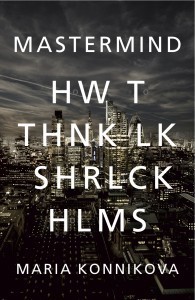 It is for that very reason that I couldn’t resist seizing the opportunity to ask Mrs. Konnikova a few questions. Her book alone is in itself one of the most brilliant bits of thinking I’ve seen in quite a while. While different Mentalists specialize in various things, my focus has always been on the psychological aspects, namely human behavior. Reading people and deductive reasoning are specialties of mine so a book marrying the psychology and the mind of Sherlock Holmes thrills me to no end. Let’s jump right in:
It is for that very reason that I couldn’t resist seizing the opportunity to ask Mrs. Konnikova a few questions. Her book alone is in itself one of the most brilliant bits of thinking I’ve seen in quite a while. While different Mentalists specialize in various things, my focus has always been on the psychological aspects, namely human behavior. Reading people and deductive reasoning are specialties of mine so a book marrying the psychology and the mind of Sherlock Holmes thrills me to no end. Let’s jump right in:
“How To Think Like Maria Konnikova”
Your autobiographical blog posts are may I say, moving and eloquent – I walk away from them thirsty for a full scale book – any chance?
Perhaps at some point—though not likely soon. I can see incorporating autobiographical elements into other books, but a full-on memoir? I don’t think I’ve lived enough for that.
Haha, fair enough. So would you think it logical next to write a book about what you term “Watsonian Thinking”?
I don’t really think so. I’ve said basically everything I’ve wanted to say about it within the confines of Mastermind. It serves as part of the dual-thought framework that needs Holmes as its trusty counterpart.
Understandable and very well said, can you give one or two illustrations of “mindful thinking” enhancing your own life?
The greatest benefit I’ve seen of mindfulness in my own life is within my writing. I never before realized how often I multitasked while working on something, how frequently I stopped observing and indulged instead in a self-distracting frenzy. Now, I’m much more aware of that. My writing has become more focused as a result – and I’ve become more productive.
A lesson we can all learn from indeed. Is it logical to write a book at some stage about Conan Doyle, who, clearly, could think like both Holmes and Watson?
Yes, I think it’s very logical for someone to undertake that project. I don’t think, however, that the someone will be I. I don’t think I will be returning to this particular theme for quite some time. Live long enough with a topic, and you stop seeing it with the requisite perspective.
Very true, and your plate is very full at the present! Next question, we share similar childhood obstacles – and similar success in overcoming them (as much as one can) to an uncanny extent – do you find those early experiences still have impact in adulthood?
Oh, of course. I think my childhood experience played a big part in making me the person I am today. My love of language, my choice of career, my appreciation of all of the options that I have open to me—and the sacrifices my family made to make that possible—it all comes from my childhood.
That I can certainly identify with! Without giving anything away (you’re working on a fiction book) would you ever write a detective novel?
I don’t know. It’s not really how my mind works—though I wish it were. Perhaps some day, I’ll find a detective novel within me. But for now, my fiction is decidedly un-detective-novel-esque.
lol, well I certainly look forward to reading whatever you put forth. A recent interviewer commented that your books seem to be your best friends – who are your favorite authors, fiction and non-fiction?
There are really too many to name, but in no particular order, my absolute favorites are Fitzgerald, Auden, Nabokov, Hemingway, Brodsky, and Bulgakov. Dostoevky comes in close after that. And I couldn’t live without my other favorite Russian poets: Akhmatova, Tsvetaeva, Mandelstam. I realize I shouldn’t say this as someone who writes non-fiction, but I don’t tend to read much of it. My favorite non fiction writers also happen to be my favorite fiction writers: Auden and Brodsky. Their non-fiction essays have changed my life.
Quite the brilliant palate there! So back to Holmes, have you seen film/TV versions of Holmes – which do you think is best? Which are favorites?
Most of them are great in their own way, but I must admit an affinity to the two most recent incarnations, Benedict Cumberbatch and Jonny Lee Miller. They both capture the spirit of Holmes remarkably well. And they are young. We tend to forget just how young Holmes was at the beginning of the canon.
Indeed. How do you respond to this statement? –at your core you are more writer than psychologist.
Agree, a hundred percent. That is always how I have seen myself.
Interesting, and lastly are you known/published in your native country of Russia? Is that important to you?
I am not very well known at all, that I am aware of, but some of my pieces have been translated into Russian for the Russian press. And Mastermind will be published in Russian, as well. That’s exciting to me. I’d love for people there to know who I am.
I’m sure anyone who doesn’t will soon enough. I suspect you’ll be a huge success wherever your work is available. Thanks so much for taking the time to answer these few questions, I know you’re a very busy woman these days. Good luck to you in all your endeavors Maria!
You’re very welcome and thanks so much for having me!
Find out more about Maria Konnikova and her wonderful new book:
www.mariakonnikova.com/
Amazon.com: Mastermind: How to Think Like Sherlock Holmes …
Maria Konnikova (mkonnikova) on Twitter
Literally Psyched – Scientific American Blog Network
Maria Konnikova on How to Think Like Sherlock Holmes – YouTube
A quick special thanks to Ray Wilcockson for his always brilliant thoughts and input…
——————————————————————————————————————————
Joe’s book (raising funds for Save Undershaw) ‘The Real Sherlock Holmes’ is available at all good bookstores including Barnes and Noble, Amazon, and in all formats including Amazon Kindle and now on the iPad too. Fans outside the US and UK can get free delivery from Book Depository





January 9, 2013
Seven things about me…
There’s a fun trend spreading around some Sherlockian blogs at the moment. A couple weeks ago Dan Andriacco and Amy Thomas both posted “Seven Things About Me” on their blogs. (you can view these posts by clicking on the authors name) At the end of these posts they tagged seven other bloggers they want to do the same thing. Now Leah Guinn, Luke Kuhns and my digitally adopted father/nemesis Ray Wilcockson have followed suit. I’ve now been tagged so it’s my turn.
Note: Ray Wilcockson, correctly deducing I would find a way to work his name into this post in some deliciously nefarious way, provided “Anti-Riggs Counter Measures” in his post that went live just moments ago. Well Ray, After my list I will retaliate. But for now, here’s my seven:
I am an avid musician. I have been fascinated with stringed musical instruments since I was a child. I play quite a few instruments including violin, guitar, upright bass, mandolin & dulcimer.
I have a morbid fear of heights. While one of Sherlock Holmes defining moments was going over the edge of the Reichenbach Falls with Professor Moriarty, you would have never gotten me near the edge.
I do not enjoy sports. While I have nothing against any particular sport, none have ever captured my interest. Most guys stereo-typically have some sport addiction, I however do not watch any.
I’ve had a lifelong obsession with the British. This is a strange one indeed but from the time I was very young I have always been fascinated by all things British. I am not sure if this stems from my love of Holmes, my mother always told me I’ve been this way since I could speak. She was married briefly to an Englishman when I was about seven years old, perhaps that had a hand in it. Go UK!

Jeremy Brett was/is my imaginary friend. Not kidding friends, my childhood imaginary friend took the form of the great Jeremy Brett. I was fascinated by him at a very young age and to this very day at 33 years old when I need to think aloud or hash out new ideas I still pretend i’m conversing with him. (This is not an unpleasant delusion.)
I had a crippling speech disorder as a child. In grade-school I had a severe stutter, to the point I barely talked. I didn’t answer a phone until I was a teenager, I was petrified of social situations. No one would have ever imagined I would become a public figure/speaker. While I no longer have the issue, it still peeks its head out here and there, yet never with any severity.
I am a complete sap. I’m a sucker for a good “chick flick” as they call them. I’ve always loved a well written happy ending. Movies such as “The Princess Bride,” “Love Actually” and “Serendipity” are among some of my very favorite films. Keep this one between us. Shh…
Well there you have it, seven random things about me. Now time for…
FIVE TRUTHS RAY WILCOCKSON DOESN’T WANT YOU TO KNOW
He is not British, he lives in Topeka Kansas with three mules and fifteen wives.
He is the sole writer for CBS’ Elementary.
He has a plethora of children which he has strategically positioned into every known Sherlockian group. He now wields power from this puppet regime.
Twitter was his brainchild, a way of capturing new wives…. (he has his methods)
He IS in fact my biological father. If you do not believe me, just ask one of my biological mothers.
Now I’m suppose to tag seven other Sherlockian bloggers to do the same. Minus the bit above, of course. So I nominate:
The Stormy Petrels
Mattias Boström
No Place Like Holmes
Heidi Thiemann
Alistair Duncan
Matt Laffey
Tracey Revels

Seven Things About Me
——————————————————————————————————————————
Joe’s book (raising funds for Save Undershaw) ‘The Real Sherlock Holmes’ is available at all good bookstores including Barnes and Noble, Amazon, and in all formats including Amazon Kindle and now on the iPad too. Fans outside the US and UK can get free delivery from Book Depository





The greatest gift I was ever given… Sherlock Holmes comes around full circle…
In life we have very few truly profound moments, I just had one of mine…
For the past week or so I’ve been visiting the small town where I grew up, I left this place when I was 17 years old and have never came back, not once. Since I’ve been back it has been quite the trip down memory lane, but nothing compares to last night…
During my childhood years my best friend was a kid by the name of Sean Mcdonald, his family was my second family. I spent as much time at his house growing up as I did my own. Some of my fondest memories are from time I spent with his father Mike, one of the coolest people I’ve ever known. Yet somewhere along the way I forgot he changed my life forever, until I was reminded last night.
I went to visit Sean and his family last night, hugs abounded. While visiting with them and regaling them with stories from my adventures they mentioned how proud they were of me, and how they never knew introducing me to Sherlock Holmes would have such an effect on me… Introducing me to Sherlock Holmes? Say what?
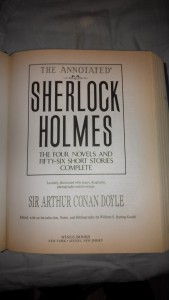 For years, during interviews and so forth I have credited my mother with my introduction to Holmes, I remember asking her for Holmes stories and her ordering them for me, but as it turns out, she was not the inspiration. Rather I was asking her for the books for a reason, because of an interest that had been sparked elsewhere…
For years, during interviews and so forth I have credited my mother with my introduction to Holmes, I remember asking her for Holmes stories and her ordering them for me, but as it turns out, she was not the inspiration. Rather I was asking her for the books for a reason, because of an interest that had been sparked elsewhere…
Standing at the Mcdonalds’ house last night it all came rushing back, Sean’s father Mike is a Sir Arthur Conan Doyle fan, he pulled out The Annotated Works Of Sherlock Holmes and spoke of Basil Rathbone. The memories came flooding back, how could I forget the true source of my Sherlockian obsession I suppose I was just too young. Last night as they nudged my memory it was like being hit by a tidal wave. There I was standing in the very house where I first heard the name, Sherlock Holmes. Standing face to face with the man that had first told me the stories of a ex-army surgeon and his friend, the consulting detective.
I’m sorry dear mother, you did facilitate my obsession but Mike Mcdonald set that fire. To him I owe this credit, to him I owe the life I have led and the person I have become. I sat there last night thumbing through his copy of The Annotated Works Of Sherlock Holmes, with in depth features about Doyle and Professor Joseph Bell. Names that would mean so much to me for the rest of my life.
My childhood was rough indeed, my mother an on again off again addict, my household one of major dysfunction 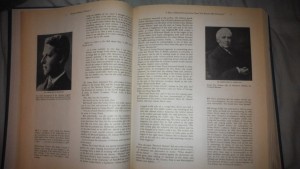 and chaos. Sherlock Holmes was always my escape, mother with her psychic readings and manic mood swings created the perfect atmosphere for a child who needed logic, who needed a hero in control of his emotions. A role model that would save him from metaphysical nonsense and emotional roller coasters. For me, that was Holmes.
and chaos. Sherlock Holmes was always my escape, mother with her psychic readings and manic mood swings created the perfect atmosphere for a child who needed logic, who needed a hero in control of his emotions. A role model that would save him from metaphysical nonsense and emotional roller coasters. For me, that was Holmes.
Sir Arthur Conan Doyle has no doubt changed many worlds with his profound writing. He certainly changed my life for the better. Today I thank Mike Mcdonald, one of the only father figures I’ve ever had. What would my life be like without Sherlock Holmes? I am glad that I shall never be able to answer that.
Thank you Mr. Mcdonald, I owe you a debt deeper than I can express in words. So I leave you with the ever so appropriate words of you-know-who…
“Life is infinitely stranger than anything which the mind of man could invent. We would not dare to conceive the things which are really mere commonplaces of existence. If we could fly out of that window hand in hand, hover over this great city, gently remove the roofs, and and peep in at the queer things which are going on, the strange coincidences, the plannings, the cross-purposes, the wonderful chains of events, working through generations, and leading to the most outre results, it would make all fiction with its conventionalities and foreseen conclusions most stale and unprofitable.” -Sherlock Holmes - A Case Of Identity
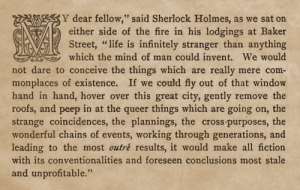
Truer words never spoken…
——————————————————————————————————————————
Joe’s book (raising funds for Save Undershaw) ‘The Real Sherlock Holmes’ is available at all good bookstores including Barnes and Noble, Amazon, and in all formats including Amazon Kindle and now on the iPad too. Fans outside the US and UK can get free delivery from Book Depository





December 24, 2012
I Was Recently Interviewed By The Stormy Petrels; The Strangest… And Funnest One I’ve Ever Done.
Friends this was truly the most entertaining interview I’ve ever been a part of. We quickly fell in and out of a more conversational format allowing for a plethora of verbal side stepping and witty banter. You’ll see straight away from the title of the interview, something is afoot…
We wound up chatting for countless hours. Soon after the lovely ladies over at The Petrels Of Crime went through what must have been the fascinating process of dissecting hours of rapid fire subject changing to determine the best snippets to include in this write up they’ve done.
Enjoy… 
What they had to say:
“Let me just start this article off by stating straight out that this was by far the coolest and most engaging, yet delightfully spontaneous conversation I’ve had in a very long time. I really wasn’t sure what to expect with it, but as it turned out, we hit it off phenomenally well and ended up talking for something like seven hours. (We cut the call at about 4:00 in the morning.) HamishMD was able to join us for part of this one, such that the first thing I heard when I opened up the recording was a tidal wave of raucous three-way laughter. Yeah. You know it must have been good when everyone was laughing hysterically right from the beginning. It was deeply refreshing and an awful lot of fun. It’d been a really long time since I’d laughed that hard, or that much.”
Click below to read the full interview:
‘Nasal Rathbone’ Meets ‘Nostrildamus’ ~ Interview with Joe Riggs – 9/7/2012 « The Stormy Petrels.
——————————————————————————————————————————
Joe’s book (raising funds for Save Undershaw) ‘The Real Sherlock Holmes’ is available at all good bookstores including Barnes and Noble, Amazon, and in all formats including Amazon Kindle and now on the iPad too. Fans outside the US and UK can get free delivery from Book Depository

November 19, 2012
Book Review: “Holmes And Watson: End Peace” by David Ruffle
Hello friends, I’ve recently finished “Holmes And Watson: End Peace” by David Ruffle. I couldn’t wait to share my thoughts on this very innovatively written little masterpiece. So here goes…
[image error]End Peace is filled with nothing but my favorite part of any Sherlock Holmes pastiche, dialogue. This fascinating book is literally 100% dialogue, it reads like an actual transcript of one long conversation and is completely delightful to digest.
The book takes place at the very end of Holmes and Watson’s years together. What we have here is a retrospective look at their career and adventures together from the vantage point of a “final’ conversation between our two beloved characters. However while that premise may seem pretty straightforward, Ruffle manages to throw in some VERY original and captivating twists and turns that keep you absolutely rapt. I do not exaggerate in the least when I say this.
Aside from the oh so curious way in which this conversation takes place and the mystery that encapsulates it, we have even more to be excited about. Answers to many questions and light shed on many stories from the canon! Who doesn’t love that idea?
During this retrospective conversation the duo go about discussing the fate of many characters from the original Conan Doyle stories as well as some of those cases that Watson often mentioned yet never chronicled. For example we learn what became of Detective Inspector Lestrade, Mrs. Hudson, Mary Morstan and many more characters that impacted the lives of Holmes and Watson. Call it literary closure if you will and masterfully done if I may say so myself.
Holmes and Watson also take the time to finally say things to each other they’ve always wanted and/or needed to, yet never have due to pride, respect or perhaps both. They are very candid with each other and “let some things out” that have been building up all these years. They also finally express some sentiments that will leave any Sherlockian/Holmesian, touched. Don’t worry, David does this perfectly and their “honest moments” are done with elegance and tact. You’ll have to read for yourself to see exactly what I mean.
David Ruffle is no stranger to writing brilliant books and this one follows suit. Given the majority of the[image error] subject matter in this book there is not much else I can say about the content without the risk of spoiling it for those of you who have yet to read it. On that note I will leave you with this:
If you love Sherlock Holmes, buy this today. If you love good books, buy this today. If you ever wondered what happened to any of your favorite characters, buy this today. If you would be interested in listening in on a “final” retrospective conversation between Holmes and Watson, then seriously, buy this today.
This book is well worth its weight in gold. It is fun, mysterious, emotionally captivating, full of twists and did I mention it’s 100% dialogue! No filler, no fluff, just the words of our beloved Sherlock Holmes and Doctor John Watson. Well done Mr. Ruffle, well done…
“Holmes and Watson: End Peace” is available in the USA from bookstore such as Barnes and Noble and Amazon, also in the UK at Waterstones, Amazon and Book Depository (free worldwide delivery).
———————————————————————————————————————–
Joe’s book (raising funds for Save Undershaw) ‘The Real Sherlock Holmes’ is available at all good bookstores including Barnes and Noble, Amazon, and in all formats including Amazon Kindle and now on the iPad too. Fans outside the US and UK can get free delivery from Book Depository

Book Review: “Holmes And Watson: End Peace” by David Ruffle
Hello friends, I’ve recently finished “Holmes And Watson: End Peace” by David Ruffle. I couldn’t wait to share my thoughts on this very innovatively written little masterpiece. So here goes…
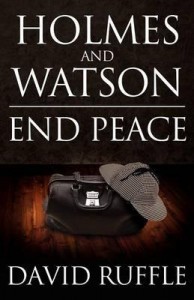 End Peace is filled with nothing but my favorite part of any Sherlock Holmes pastiche, dialogue. This fascinating book is literally 100% dialogue, it reads like an actual transcript of one long conversation and is completely delightful to digest.
End Peace is filled with nothing but my favorite part of any Sherlock Holmes pastiche, dialogue. This fascinating book is literally 100% dialogue, it reads like an actual transcript of one long conversation and is completely delightful to digest.
The book takes place at the very end of Holmes and Watson’s years together. What we have here is a retrospective look at their career and adventures together from the vantage point of a “final’ conversation between our two beloved characters. However while that premise may seem pretty straightforward, Ruffle manages to throw in some VERY original and captivating twists and turns that keep you absolutely rapt. I do not exaggerate in the least when I say this.
Aside from the oh so curious way in which this conversation takes place and the mystery that encapsulates it, we have even more to be excited about. Answers to many questions and light shed on many stories from the canon! Who doesn’t love that idea?
During this retrospective conversation the duo go about discussing the fate of many characters from the original Conan Doyle stories as well as some of those cases that Watson often mentioned yet never chronicled. For example we learn what became of Detective Inspector Lestrade, Mrs. Hudson, Mary Morstan and many more characters that impacted the lives of Holmes and Watson. Call it literary closure if you will and masterfully done if I may say so myself.
Holmes and Watson also take the time to finally say things to each other they’ve always wanted and/or needed to, yet never have due to pride, respect or perhaps both. They are very candid with each other and “let some things out” that have been building up all these years. They also finally express some sentiments that will leave any Sherlockian/Holmesian, touched. Don’t worry, David does this perfectly and their “honest moments” are done with elegance and tact. You’ll have to read for yourself to see exactly what I mean.
David Ruffle is no stranger to writing brilliant books and this one follows suit. Given the majority of the subject  matter in this book there is not much else I can say about the content without the risk of spoiling it for those of you who have yet to read it. On that note I will leave you with this:
matter in this book there is not much else I can say about the content without the risk of spoiling it for those of you who have yet to read it. On that note I will leave you with this:
If you love Sherlock Holmes, buy this today. If you love good books, buy this today. If you ever wondered what happened to any of your favorite characters, buy this today. If you would be interested in listening in on a “final” retrospective conversation between Holmes and Watson, then seriously, buy this today.
This book is well worth its weight in gold. It is fun, mysterious, emotionally captivating, full of twists and did I mention it’s 100% dialogue! No filler, no fluff, just the words of our beloved Sherlock Holmes and Doctor John Watson. Well done Mr. Ruffle, well done…
“Holmes and Watson: End Peace” is available in the USA from bookstore such as Barnes and Noble and Amazon, also in the UK at Waterstones, Amazon and Book Depository (free worldwide delivery).
———————————————————————————————————————–
Joe’s book (raising funds for Save Undershaw) ‘The Real Sherlock Holmes’ is available at all good bookstores including Barnes and Noble, Amazon, and in all formats including Amazon Kindle and now on the iPad too. Fans outside the US and UK can get free delivery from Book Depository

November 10, 2012
Book Review: “The Secret Journal of Dr. Watson” by Phil Growick
Friends, I am excited to begin what shall be a series of reviews. I am currently digesting a slew of Sherlock Holmes related books and will be reviewing each one upon its completion. The first of which is Phil Growick‘s “The Secret Journal of Dr. Watson.”
[image error]The premise of this book is rather pleasing, one last Holmes adventure chronicled by of course Dr. Watson. However unlike other novels with the same premise, this one stands apart in several ways, all of which are nothing less than enthralling. While elements of the book must be kept secret for the to-be, I can tell you that a descendant of the good Doctor finds himself in possession of this secret journal, and this, is by Dr. Watson’s own design. A wonderful hook right at the start of this book and yet only the beginning of what shall be a most epic journey.
Mr. Growick’s attention to detail and intricate knowledge of geography and world history is staggering, throughout this book we find Holmes and Watson in the middle of a series of world events. Events that due to his superb writing style marry fiction and non-fiction in such a way that you begin to believe that not only did Holmes exist, that he may have had a hand in the course of our natural history. This is a rather pleasant sensation and one that will remain with you throughout the book.
Growick clearly loves to take you down a path, then throw you off the path only to then make you wonder if that path ever existed at all. The ploys, ruses and plots that constantly unfold throughout the book are brilliant, well crafted and nothing less than what we would expect of Holmes. As most of us know I adore the deductions of Holmes and draw many of my conclusions from the authors use of them as well as their plausibility and substance. Phil Growick does not disappoint.
The deductions of Holmes in this book are beyond excellent, extremely engaging and worthy of re-reading quite a few times, I certainly did. However some of the best deductions and moments of logical thinking come to us in a contemplative form. We peer in to see Holmes thought process quite often as he often confides to Watson what is going through his mind. Seeing as how Sherlock is rightfully suspicious of nearly ever character he comes into contact with on this journey, we are fed plenty of well crafted deductions and extremely elegant breakdowns.
As you follow Holmes and Watson through this non stop adventure you find yourself right there with Sherlock, asking questions, developing answers which lead you to even more questions. You begin to read faster, the sound of the turning pages ever increasing like an out of control metronome.
While some books end with a sense of closure, others with a feeling of confusion, this wonderful [image error]tale leaves you literally begging for just a few more pages. You find yourself examining the back cover closely to see if Mr. Growick has sealed inside some hidden envelope with the answers to a few tantalizing cliffhangers. Something, upon reading his work I would not put it past him to do.
Get this book, download it to your favorite device or sit back on the couch with the paperback copy as I did. However you prefer to read it, just do so and you will not be disappointed. This is an epic journey that spans the time frame of nearly a century. As I sit here typing this I still find myself with the urge to contact Mr. Growick and offer him bribes for an envelope with just one more page in it…
-Joe Riggs
Follow Phil Growick on Twitter.
Buy “The Secret Journal of Dr. Watson” on Amazon.
—————————————————————————————————
Joe’s book (raising funds for Save Undershaw) ‘The Real Sherlock Holmes‘ is available all good bookstores including Barnes and Noble, Amazon, and in all formats including Amazon Kindle and now on the iPad too. Fans outside the US and UK can get free delivery from Book Depository.


